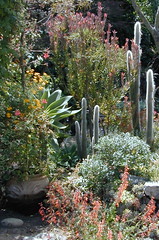fet·ish·ism: Excessive attachment or regard. (Sorry, no sexual or religious overtones intended but perhaps just a dash of magic, as I have no idea where inspiration comes from.)
When I first coined my cyber name, "serialplantfetishist", it was a pretty accurate description. My yard was huge and largely barren while my awakening appetite for new and amazing plants was voracious bordering on obsessive.
The urge to acquire special plants is no longer my strongest motivation in the garden. Now I'm more tuned into the way the whole space feels to move through,

the balance of mass and emptiness,
light and shadow,
texture and color.
In the beginning, I started making a garden as a result of having kept small birds in outdoor aviaries.
I had three outdoor aviaries stocked with finches, weavers and softbills. While researching plants to grow in the aviaries I became interested in plants which would enhance the habitat value of our yard for birds and insects.
Deciding where and how to place those plants led to my interest in gardening. The practical considerations of compatible cultural requirements was something I've learned (to the extent that I have) by trial and error. The same goes for finding out about the cold and heat tolerance of the plants I've sought out. (I've mulched more than a few.)
From the start I've favored gardens which feel plausibly natural. Formal geometry in a garden is something I can enjoy in other peoples gardens but is not anything I'm drawn to create in my own. My biggest influence was the Harland Hand garden in El Cerrito, California. What I like about that garden is how sculptural the whole place is as well as how natural it felt despite the inclusion of many exceptional plants which obviously could never cohabitate without human intervention. His garden was inspired by trips to the Sierras but it wasn't intended as a faithful recreation of any particular place he'd seen. Instead, his garden shows how his experience of those places inspired his sense of the beauty of nature which then informed the aesthetic choices which shaped his garden.
In my own garden, I'm more interested in the quality of my relationship to the garden than I am in it as an object. I don't want to figure out a grand design and then work to shape the garden accordingly. To me, the process of making the garden is more interactive. You are given inspiration.
You act on it. You step back and see more possibilities.
You act on some of those, and so on.
I'm far more interested in the journey than the destination.



















Having a clear goal in sight is a good thing, but the path you're going to take is just as important. People say that you have to live in the moment. I find it nice that you actually think of how you're going to reach your end design, rather than think of the end design itself.
ReplyDeleteGrette Spadoni